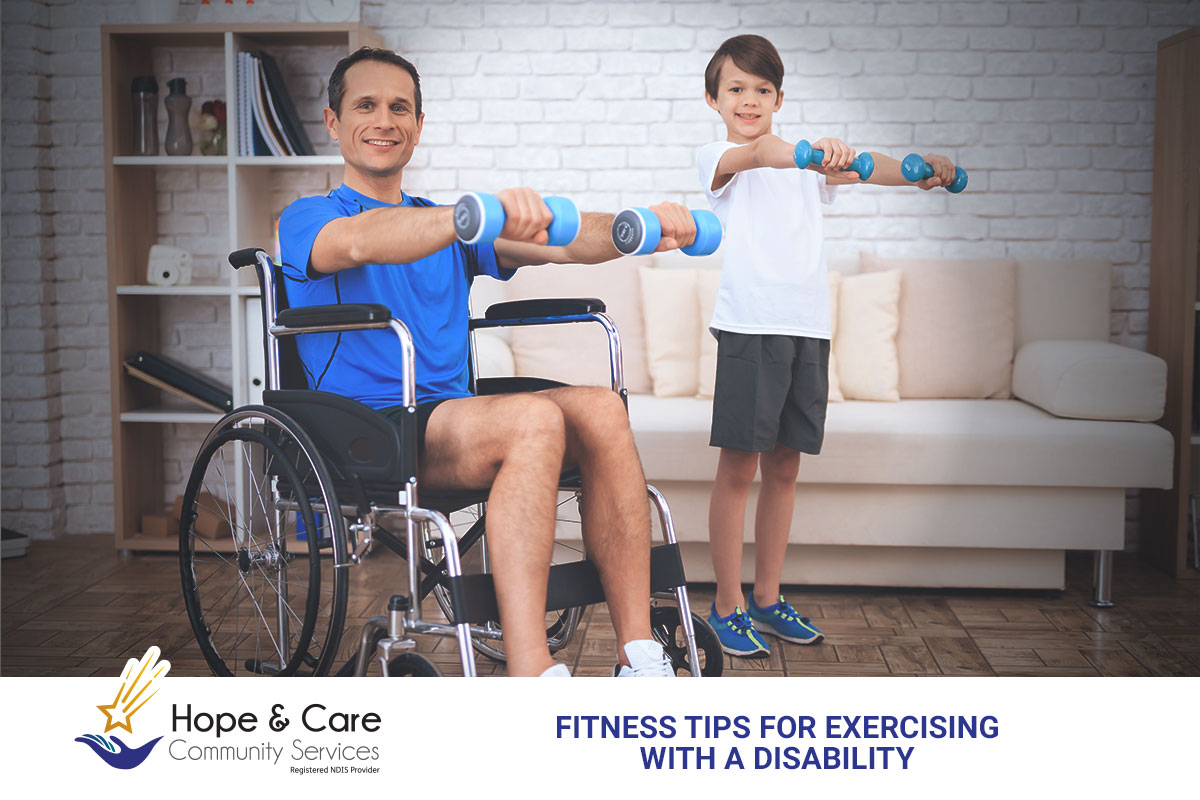
Exercise is a powerful way to improve your physical and mental well-being. For individuals living with disabilities, regular physical activity can boost mobility, increase strength and improve overall quality of life. At Hope & Care Community Services, we are committed to empowering everyone to enjoy the benefits of an active lifestyle. That is why we have compiled these fitness tips for disability, designed to help you embrace fitness with confidence by providing practical strategies to make exercising safe, enjoyable and rewarding.
Why Exercise Matters for People with Disabilities
Staying active offers countless benefits. Beyond improving your physical health, exercise can reduce stress, enhance mood and boost self-esteem. It also helps manage chronic conditions, promotes better sleep and fosters a greater sense of independence. By adopting an exercise routine tailored to your abilities and incorporating these fitness tips for disability, you can unlock a healthier, more fulfilling life.
Consult Your Healthcare Team First
Before diving into any fitness program, it is crucial to speak with your healthcare team. Your doctor, physiotherapist, or exercise physiologist can:
- Assess your current health and recommend safe activities.
- Help you identify potential risks and prevent injuries.
- Guide you in creating a personalised fitness plan.
Starting with professional advice ensures you can exercise safely and effectively while achieving your goals.
Choose Activities That Match Your Abilities
Selecting exercises tailored to your needs is essential for success. By focusing on activities that align with your abilities, you can stay motivated and avoid unnecessary strain. Here are a few ideas:
- Seated Exercises: Chair yoga, resistance band stretches, or light dumbbell workouts are great options for improving flexibility and strength.
- Water-Based Activities: Swimming or aqua therapy reduces joint impact while building cardiovascular endurance and muscle tone.
- Walking or Rolling: Walking aids or using a wheelchair to roll outdoors provides a refreshing and accessible way to stay active.
Customising your routine ensures every movement counts toward your fitness journey. One of the most important fitness tips for disability in this context is to select exercises that you can comfortably perform while steadily building strength and endurance.
Set Clear and Realistic Goals
Goal-setting helps you stay focused and motivated. Start small and build up gradually to keep things manageable. For instance:
- Aim for 15 minutes of movement three times a week at first.
- Gradually increase your sessions to 30 minutes or add light resistance as you grow stronger.
- Celebrate your milestones, such as completing a full week of activity or reaching a personal best.
By tracking your progress, you will see how far you have come, keeping your enthusiasm high.
Use Adaptive Equipment and Technologies
Modern assistive tools make exercise more inclusive and accessible than ever. Incorporating these devices into your routine can make a significant difference:
- Hand cycles: Ideal for cardiovascular training, especially for individuals with lower-body mobility challenges.
- Resistance Bands: Lightweight and versatile, they can strengthen muscles without strain.
- Adaptive Rowing Machines: Perfect for building upper-body strength while sitting.
With the right tools, you will feel empowered to take on new challenges in your fitness routine.
Join Adaptive Sports or Community Programs
Adaptive sports not only improve fitness but also create opportunities to socialise and have fun. Whether you are a beginner or an experienced athlete, there is something for everyone:
- Wheelchair Basketball: A fast-paced sport that improves endurance and teamwork.
- Para-Swimming: Offers a full-body workout in a low-impact environment.
- Boccia: Enhances precision, strategy and concentration in a relaxed setting.
Joining community programs can help you stay connected while enjoying the benefits of group activities.
Build a Strong Support System
Exercising with friends, family, or a workout buddy makes the journey more enjoyable. Surround yourself with people who encourage you to stay active and celebrate your achievements. Here are some tips:
- Enroll in local fitness classes designed for people with disabilities.
- Participate in online groups or forums to share your progress and gain inspiration.
- Ask a friend or family member to join you during workouts for extra motivation.
Support networks help you stay accountable and make fitness feel like a team effort.
Listen to Your Body and Rest When Needed
Pushing too hard can lead to injuries or burnout. Pay attention to how your body feels and adjust your activities accordingly:
- If you feel pain or discomfort, stop immediately and reassess.
- Make rest days part of your routine to allow your body to recover and rebuild.
- Use stretches or gentle movements to ease soreness and maintain flexibility.
Finding the right balance between activity and rest is key to long-term success.
Leverage NDIS Resources for Fitness Support
The National Disability Insurance Scheme (NDIS) can make fitness more accessible by funding services like personal training and exercise physiology. Through NDIS support, you can:
- Work with professionals to develop a customised fitness plan.
- Access adaptive equipment and specialised programs.
- Receive guidance to safely achieve your fitness goals.
Incorporating fitness into your NDIS plan empowers you to take control of your health and well-being.
Conclusion
Exercising with a disability opens the door to countless physical and mental health benefits. By consulting professionals, choosing tailored activities and setting realistic goals, you can create a fitness routine that works for you. By following these fitness tips for disability, every step—no matter how small—brings you closer to a healthier, more active life.
At Hope & Care Community Services, we are here to support you every step of the way. Your fitness journey starts today!
Want to learn more? Read other articles :
- Redefine Independence your own way – with HCCS
- Who’s Who: The Key Terms of Your NDIS Plan
- Foundational Supports: Building Blocks of NDIS Success
HCCS is a registered NDIS provider. Learn more about our services.
♥ We are available in Brisbane! – Our team is just a call away!
